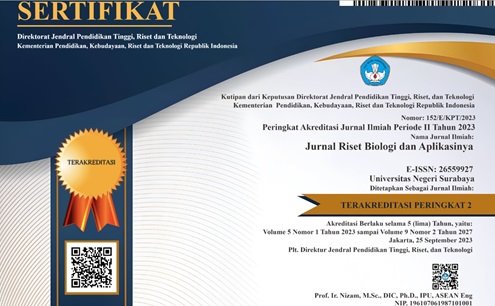Difference of Red Blood Cell Count (RBC) Levels in Diabetes Mellitus Type II with Ulcers and without Ulcers
DOI:
https://doi.org/10.26740/jrba.v2n1.p6-10Keywords:
ulcers, without ulcers, diabetes mellitus, RBC, HGBAbstract
Type II diabetes mellitus (T2DM) is a metabolic disorder that has potential causing ulcer complications. Ulcers occur due to peripheral vascular abnormalities and trauma. The occurrence of ulcers allows differences in the hematology characteristics in sufferers. This study aimed to determine the comparison of the blood picture between T2DM with ulcers and T2DM without ulcers. This was analytical descriptive research using 29 samples (10 T2DM samples with ulcers and 19 T2DM samples without ulcers). A complete blood test was performed using Sysmex Kx-21N hematology analyzer. Data were analyzed using Independent T-test and Mann-Whitney U depends on the normality. Normality was done using Shapiro Wilk (Confident Level: 95%). The results of this study indicated that Red blood cell count (RBC) and Hemoglobin Count (HGB) differ significantly between T2DM with ulcers and T2DM without ulcers (p: 0.012 and 0.006). The identification of HGB levels was highly recommended to get proper treatment in T2DM.
References
Abate, A., Birhan, W., & Alemu, A. (2013). Association of anemia and renal function test among diabetes mellitus patients attending Fenote Selam Hospital, West Gojam, Northwest Ethiopia: A cross sectional study BMC Hematology. BMC Blood Disorders, 13(1), 1-12. doi: 10.1186/2052-1839-13-6.
Alexiadou, K., & Doupis, J. (2012). Management of diabetic foot ulcers. Diabetes Therapy, 3(1), 1-15. doi: 10.1007/s13300-012-0004-9.
Aumiller, W. D., & Dollahite, H. A. (2015) Pathogenesis and management of diabetic foot ulcers. Journal of the American Academy of Physician Assistants, 28(5), 2834. doi: 10.1097/01.JAA.0000464276.44117.b1.
Biadgo, B. (2016). Hematological indices and their correlation with fasting blood glucose level and anthropometric measurements in type 2 diabetes mellitus patients in Gondar, Northwest Ethiopia. Diabetes, Metabolic Syndrome and Obesity: Targets and Therapy, 9(1), 9199. doi: 10.2147/DMSO.S97563.
Christa, M.W.R. (2014). Hematological Parameters and Prediabetes and Diabetes in Adults from the General Population: A Cross-Sectional Study. Journal of Diabetes & Metabolism, 5(2), 335. doi: 10.4172/2155-6156.1000335.
Ekoe, J.M., Goldenberg, R., & Katz, P. (2018). Clinical Practice Guidelines - Screening for Diabetes in Adults Diabetes Canada. Canadian Journal of Diabetes, 42, S109S114. doi: 10.1016/j.jcjd.2017.10.013.
Fitria, E., Nur, A., Marissa, N., & Ramadhan, N. (2017). Karakteristik Ulkus Diabetikum pada Penderita Diabetes Mellitus di RSUD dr. Zainal Abidin dan RSUD Meuraxa Banda Aceh. Buletin Penelitian Kesehatan, 45(3), 153 - 160. doi: 10.22435/bpk.v45i3.6818.153-160.
Hu, F.B. (2011). Globalization of diabetes: The role of diet, lifestyle, and genes. Diabetes Care, 34(6), 12491257. doi: 10.2337/dc11-0442.
Kizilgul, M., Sencar, E., Ucan, B., Beysel, S., Ozcelik, O., Ozbek, M., & Cakal, E. (2018). Components of the Complete Blood Count in Type 2 Diabetes Mellitus with Inadequate Glycemic Control. Dicle Medical Journal, 45(2), 113120. doi: 10.5798/dicletip.410811.
Kothari, R., & Bokariya, P. (2012). A Comparative Study of Haematological Parameters in Type I mellitus Patients & healthy Young Adolescents. International Journal of Biological and Medical Research, 3(4), 24292432. Retrieved from https://pdfs.semanticscholar.org/49bc/c96acd6efea6a556750b8c8273e10b9108ff.pdf.
Lathifah, N.L. (2017). Hubungan durasi penyakit dan kadar gula darah dengan keluhan subyektif penderita diabetes mellitus. Jurnal Berkala Epidemiologi, 5(2) 231239. doi: 10.20473/jbe.v5i2.2017.231-239.
Loviana, R.R., Rudy, A., & Zulkarnain, E. (2015). Artikel Penelitian Faktor Risiko Terjadinya Ulkus Diabetikum pada Pasien Diabetes Mellitus yang Dirawat Jalan dan Inap di RSUP Dr. M. Djamil dan RSI Ibnu Sina Padang. Jurnal Kesehatan Andalas, 4(1), 243248. doi: https://doi.org/10.25077/jka.v4i1.229.
Mirtha, L.T., Ariono, M., & Putra, S.M. (2018). The Effect of Foot Exercise on Diabetic Patients with Foot Ulcer: An Evidence-Based Case Report. Diabetes & Metabolic Disorders, 5(1),15. Diakases dari https://doi.org/10.24966/dmd-201x/100026.
Mohammed, R.K., Ibrahim, S., Atawodi, S.E., Eze, E.D., Suleiman, J.B., Ugwu, M.N., & Malgwi, I.S. (2013). Anti-diabetic and Haematological Effects of n-butanol fraction of Alchornea cordifolia Leaf Extract in Streptozotocin-induced Diabetic Wistar Rats. Scientific Journal of Biological Sciences, 2(3), 4553. doi: 10.13140/RG.2.2.35936.17921
Ramkisson, S., Pillay, B. J., & Sibanda, W. (2017). Social support and coping in adults with type 2 diabetes. African Journal of Primary Health Care and Family Medicine, 9(1),1-8. Retrieved from https://phcfm.org/index.php/phcfm/article/view/1405/2160.
Salman, I. N., Wadood, S. A., & Abualkasem, B. A. (2017). Low Hemoglobin Levels in Infected Diabetic Foot Ulcer. IOSR Journal of Pharmacy and Biological Sciences, 12(01),0509. https://doi.org/10.9790/3008-1201040509.
Suneja, S., Christian, Y., & Chandra, N. C. (2018). Milieu of Diabetes in the 2nd Decade of 21st Century. Journal of Diabetes & Metabolism, 09(09), 114. doi: 10.4172/2155-6156.1000804.
Thomas, M., Tsalamandris, C., MacIsaac, R., & Jerums, G. (2005). Anaemia in Diabetes: An Emerging Complication of Microvascular Disease. Current Diabetes Reviews, 1(1), 107126.https://doi.org/10.2174/1573399052952587
Tsaih, S.W., Holl, K., Jia, S., Kaldunski, M., Tschannen, M., He, H., Woods, L. C. S. (2014). Identification of a Novel Gene for Diabetic Traits in Rats, Mice, and Humans. Genetics, 198(1),1729. https://doi.org/10.1534/genetics.114.16298.
WHO. (2004). Estimates for the year 2000 and projections for 2030. World Health, 27(5), 10471053.
Wright, J.A., Oddy, M.J., & Richards, T. (2014). Presence and characterisation of anaemia in diabetic foot ulceration. Anemia, 2014, 18. doi: 10.1155/2014/104214.
Yazdanpanah, L., Shahbazian, H., Nazari, I., Arti, H. R., Ahmadi, F., Mohammadianinejad, S. E., & Hesam, S. (2018). Incidence and risk factors of diabetic foot ulcer: A population-based diabetic foot cohort (ADFC study)-two-year follow-up study. International Journal of Endocrinology, 2018. https://doi.org/10.1155/2018/7631659.
Yuhelma., Hasneli, I.Y., & Annis, N.F. (2015) Identifikasi dan Analisis Komplikasi Makrovaskuler dan Mikrovaskuler pada Pasien Diabetes Mellitus. Journal Online Mahasiswa, 2(1), 569579. Diakses dari https://jom.unri.ac.id/index.php/JOMPSIK/article/view/8343/8012.
Downloads
Additional Files
Published
How to Cite
Issue
Section
 Abstract views: 1083
,
Abstract views: 1083
, PDF Downloads: 867
,
PDF Downloads: 867
, PDF Downloads: 0
PDF Downloads: 0












